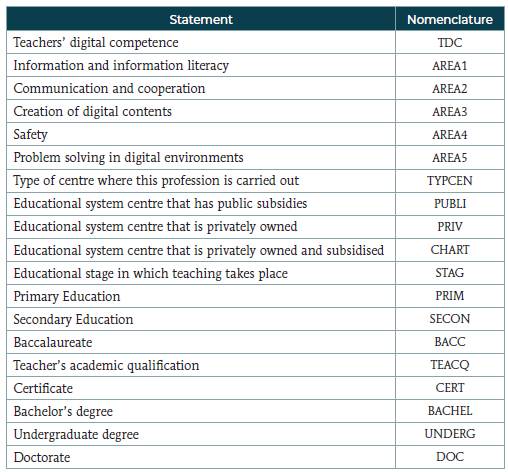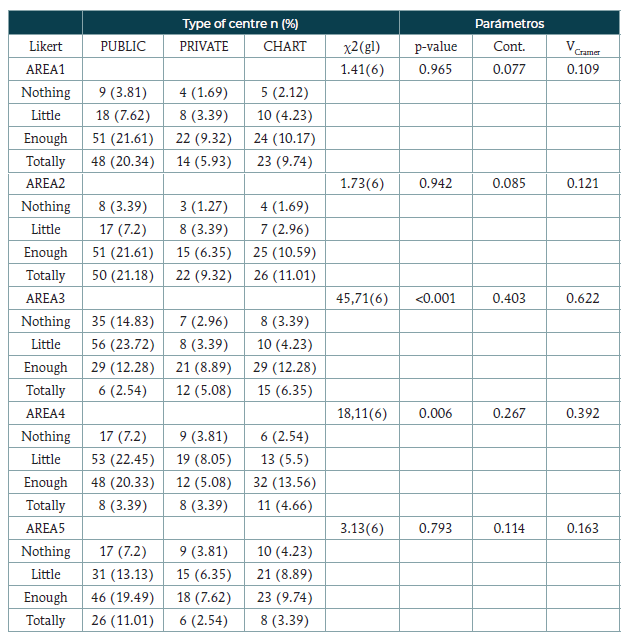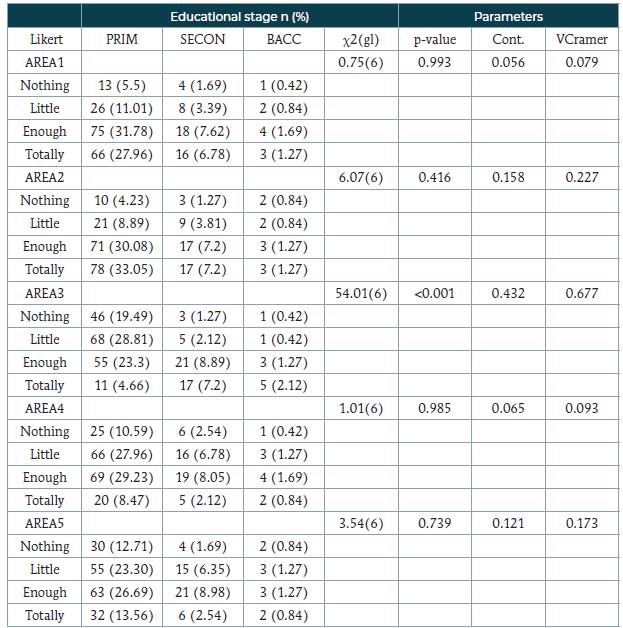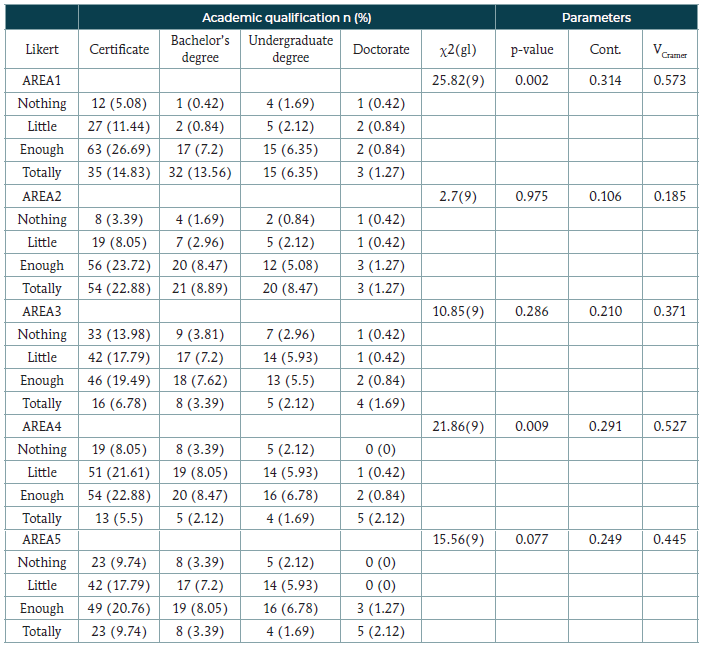INTRODUCCIÓN
Nowadays, it is undeniable that technology and technological tools occupy great part of people's life. As a result, the field of education is one of the most developed in relation to that, especially, in the processes of teaching and learning in the educational act itself (Rodríguez, Cáceres and Alonso, 2018), allowing the deployment of new pedagogical models and assets to reach efficacy in the students' learning (Camerino and Busca, 2011).
All this process subjected to technology, fostered by the on-going emergence of technologies associated with information and communication, has caused a change and a constant progress, not only in the search of information but also in other aspects such as personal relationships, problem-solving or the creation of contents of different nature (Arzola, Loya and González, 2017). It is for this reason that Physical Education, discipline that is currently having an increasing scientific relevance (Llopis, 2016), has to be constantly updated in order to equate the technological progress of education paradigms in society (Prat and Camerino, 2012).
The massive use of technological devices has led to a native digital literacy of the current generations and a constant learning of the rest of the population.
There is an exaggerated growing number of tools, resources and applications, being the digital natives the ones who have known how to adapt with the greatest simplicity to this revolution of technological nature, which comes marked by the progress in these years (Area, 2015).
For all this, ICT tools are causing a revolution at all levels in the educational field, accomplishing a fleeting but necessary education of methodologies and education paradigms, and they are also adapting to the needs of students who occupy the classrooms in education centres at this technological stage. (Viñals and Cuenca, 2016).
On the basis of the current educational legislation, Organic Law 8/2013, 9th December, which establishes the improvement of the quality of education (henceforth LOMCE), it is stated that these ICTs must be present in the different subjects of the curriculum which play a part in the official curricula. Moreover, they are an indispensable part of a positive development in the teaching process, used by teachers, and in the learning process, used properly by students.
In the light of the above considerations, ICTs have produced a pedagogical change that can lead to a type of learning, which is in general deeper and interactive, encouraging true technological experiences thanks to technology, as recognized experts in this field believe, for instance, Cabero and Barroso (2018).
The emergence of these ICTs has not only meant easier access to contents, but they have also produced several benefits regarding content and knowledge transmission on the part of teachers. ICTs allow students to be able to reach a greatest meaningful learning, taking into account each one's individualities and distinctive features (Maquilón, Mirete and Avilés, 2017). All this, turns into a process which concludes in very high indicators (González, Perdomo and Pascuas, 2017), in a more dynamic learning (Medellín and Gómez, 2018) and in a more active and prominent role on the part of the students (Mingorance, Trujillo, Cáceres and Torres, 2017), causing them to be more motivated in their daily task (Laskaris, Kalogiannakis and Heretakis, 2017).
Teachers, it could not be otherwise, have in this variety of pedagogical innovations associated to technology a way of reaching higher dynamics in their task, an accurate way of improving and updating educational processes, paying attention to what is demanded by society nowadays (Murillo and Krichesky, 2015). It is for this reason that the progress of all these methodologies based on technology is undeniable, and therefore, it is necessary to be included in the classrooms these days (Kumar and Kumar, 2018).
We cannot deny that, as any revolution of educational nature, it has created a concern in teachers, as they see themselves submitted to an instructional process in order to develop their digital competences against digital natives to whom they teach (Moreno, López and Leiva, 2018). Due to this change in education, it is required a teacher training adapted to these technologies and a technological and pedagogical updating of the skills and knowledge in the digital field needed by teachers in order to perform their work in this digital era (Aznar, Cáceres, Trujillo and Romero, 2019).
In order to reveal all concerning with the aim of this investigation, recent literature about teacher's digital competence has been examined. According to Avitia and Uriarte (2017), it is a concept in constant evolution, as well as technology and its way of integration in the educative field.
These opinions are similar to the ones of Castañeda, Esteve and Adell (2018); and Lázaro, Gisbert and Silva (2018), who believe that teachers' digital competence must be based on the capacities and skills that should be acquired by teachers in order to achieve a full integration of these tools and concepts, as well as to use digital resources satisfactorily in the training development of the students they teach.
As Durán, Gutiérrez and Prendes (2016, 529) point out, teachers are considered competent at the technological level when they are able to: organise, distinguish and choose optimally documental information; intervene and interact in developmental areas and knowledge dissemination; optimally choose and use the relevant technological and digital resources; produce exercises related with problem solving: managing tools taking into account the contextual characteristics of the learning place.
As usual, all this is seen from the pedagogical viewpoint of this technology in order to achieve a higher development of the student, and develop the maximum potential of the digital media in the educational field (Cabero, 2017; Rodríguez and Pedraja, 2017).
The National Institute of Educational Technologies and Teachers Training, henceforth INTEF, with the aim of regularising and standardising the professional competence skills at the technological level that a teacher should gather in education nowadays, has established five areas to articulate teachers' digital competence. These are set up in the following manner: Information literacy; Communication and collaboration; Digital contents creation; Safety; Problem-solving (INTEF, 2017).
Everything stated up to now, contrasts in some cases with reality. Some studies, in spite of the importance of technology in the classrooms, contrast that a lot of teachers do not have sufficient training so as to confront their functions effectively. Furthermore, it is stated that they are not able to use the innovative tools around them successfully, which are both current and ephemeral tools. That is evidenced by researches that shed light on these deficits, generating worrisome data such as lack of attitude and training (Padilla, 2018), as well as a scant knowledge of the areas that define digital competence in ICTs field (Morán, Cardoso, Cerecedo and Ortiz, 2015), which favour low skill levels ICTs (Afanador 2017; Falcó, 2017; Fernández and Fernández, 2016; Fernández, Leiva and López, 2018; López, Pozo, Vázquez y López, 2020; Pozo, López, Fernández y López, 2020; López, Pozo, Fuentes y Trujillo, 2019; López, Moreno, Pozo y López 2020).
It would be typical to think that the fact previously described takes place in teachers who are current employees, but this is not the case since a lot of future teachers, who are now students in the university classrooms, also lack the mentioned competences. Therefore, this makes us believe that teacher training in university betray a lack of digital training in the future teacher (Leiva and Moreno, 2015).
Furthermore, it has been found in literature that one of the reasons for lacking interest and ICTs inclusion in Physical Education is the insufficient temporary dedication of the subject in the current syllabus as well as the fear to reduce students' motor time (Prat, Camerino and Coiduras, 2013; Hinojo, López, Fuentes, Trujillo y Pozo, 2020). In addition to the fear of leaving the comfort zone and creating and experiencing new ways and experiences of learning (Valderrama, 2018).
As Cabero and Ruiz (2018) state, this produces a rift between teachers and students, since the first ones are considered digital immigrants, being the second ones native of this 'digital language'. According to López and Bernal (2018), the development of digital competence is assumed as something necessary and essential which has to meet the needs of native digital students who require an education development based on technology, and this, in turn, results in multiple ways of teaching and developments which form part of education.
One of the mainstream which has most emerged and developed in recent years is mobile learning (Fombona, Pascual and González, 2017), which emphasises mobile learning, based on the use of different electronic devices bringing ubiquity to the learning process, which is produced in any space-time (Brazuelo and Gallego, 2014) and in different digital and interactive means (Ramírez and García, 2017).
Due to mobile learning, an approach arises, which can be renamed as mixed since it is framed in blended learning, alternating between face-to-face learning in physical spaces and learning in virtual environments (Esparaza, Salinas and Glasserman, 2016). This is nowadays one of the tools or mainstream which has the greatest usefulness (Islas, 2016), that is not the same as a type of learning that we can consider as more effective (Fernández, Fernández and Rodríguez, 2018).
This study focuses on recognising the level of digital competence in teachers so as to perform emerging and active methodologies in Physical Education sessions. From this heading derive the following specific objectives:
Determining the level of teachers' digital competence on its five areas.
Specifying the degree of digital competence in teachers depending on the educational centre.
Discovering teachers' digital competence according to the educational stage in which they perform their job.
Knowing the level of digital competence on the basis of teachers' academic qualifications.
METHODOLOGY
In order to accomplish this work, it has been deployed a design of non-experimental research, which is descriptive and correlational throughout a quantitative method, following methodological guidelines of experts such as Hernández, Fernández and Baptista (2014).
SAMPLE OF PARTICIPANTS
In this research, a total of 236 Spanish teachers (154 men and 82 women, with an average age of 36 years) have participated in Physical Education speciality. These professionals have been chosen through a stratified random sampling, by means of the statistical considerations of Bisquerra (2004).
In table 1, the characteristics study subjects are shown.
INSTRUMENT
In order to carry out the process of collecting data, a questionnaire of nature ad hoc has been used, made taking into account the requirements of research (Alaminos and Castejon, 2006). The questionnaire is made up of 48 items that are classified in 3 dimensions, which are the following ones:
Most of the questions are presented with a response format Likert type on a rating scale from 1 to 4 (1-nothing, 2-little, 3-enough and 4-totally). Others, such as the ones included in dimension SD, follow a closed selection format.
The questionnaire was authenticated at a quality level by means of experts' judgement (Escobar and Cuervo, 2008) formed by 12 specialists in Physical Education and educational technology belonging to different universities in Spanish territory (Granada, Seville, Zaragoza and Alicante). The feedback given by these experts was useful for optimising the instrument.
Subsequently, an analysis of the main components (ACP) was accomplished for data reduction without causing the loss of relevant and pertinent information for the research. All this, through Kaiser-Meyer-Olkin (KMO) test and Bartlett's sphericity test, achieving p=0.904 y p=0.0005, consecutively, revealing an appropriate ACP. Likewise, a rotation was performed, Promax oblique type with Kaiser standardisation, in order to foster data interpretation in relation to the suggestions of Pérez (2005).
Straightaway, the internal consistency was located by means of the statistician Alpha of Cronbach, reaching high levels of a values -according to the criteria (a>0.8) established by McMillan and Schumacher (2005)- as it is shown in table 2.
Finally, with the aim of reducing the investigative bias and avoiding problems of items comprehension, a demonstration on an independent sample was performed (n=35) to the subjects of this study, following the guidance of Corral (2009).
STUDY VARIABLES
Hereafter, in table 3, the variables analysed in this research are shown with their respective nomenclatures, so as to facilitate the reading and comprehension of the work.
PROCEDURE
This research started in October, 2018. After analysing the database at educational centres (https://www.educacion.gob.es/centros/home.do) provided by the Ministry of Education and Vocational Training, a probability sampling by strata was executed, with the intention of obtaining a representative sample of each Autonomous Community and City, the type of centre and the educational stage.
One of the educational centres in each region was chosen; the first contacts with the corresponding school leaders were established with the aim of explaining briefly the objectives of the study and engaging the participation of the teachers of the Physical Education department. When a first agreement of cooperation was reached -at a later date-some videoconferences were executed to detail and explain deeply the purposes of inquiry. Likewise, these virtual meetings were useful to solve the doubts of the different entities involved, apart from guaranteeing them the anonymity of the information extracted so as to -in this way -achieve a higher impartiality of the data.
The process of data collection was made telematically, by means of a digitalised questionnaire, favouring the shipment, reception and filling of the instrument. A period of 3 weeks was established to fill the items. During this time, researchers were solving the participants' little doubts through an asynchronous communication, via e-mail.
Once the information was collected, it was prepared to be transferred to the statistical specialised programme, with the objective of performing a deep analysis of each variable presented.
Data analysis
Statistical methods such as the mean (M), standard deviation (DT), Pearson's symmetry coefficient (CAP) and Fisher's pointing coefficient (CAF) were used, as well as Pearson's Chi-square (x2) for the comparison between variable and Cramer's V test (VCramer) to determine their association degree.
The software used for the statistical analysis of the data obtained has been the Statistical Package for the Social Sciences (SPSS) v.22, considering p < 0.05 as a statistically significant difference.
ANALYSIS OF RESULTS
The data analysis has delivered certain central levels and others superior to the average of each area that make up teachers' digital competence in Physical Education (table 4). Peculiarly, these professionals have a higher level of competence rate in relation to information and information literacy as well as in communication and cooperation between the different entities involved in the teaching-learning process. Regarding the statistical methods used (CAP and CAF), a certain degree of the 'platty - kurtic dome-shaped' pointing of the asymmetric distribution in the data presented has been found.
Concerning the determination of the educational centre in which these professionals carry out their teaching duties about teachers' digital competence under consideration, table 5 reveals that professionals of the Physical Education field in private and charter schools stand out in the area related to digital content creation, taking into account the values p < 0.05 and with a high strength of association, determined by the test results VCramer > 0.6.
Likewise, the area related to safety has illustrated statistical significance, revealing that Physical Education teachers in charter centres show better skills in this area of the digital competence in comparison with the rest of educational centres, however, with a slight strength of association according to the value of test V Cramer.
Regarding the influence between the educational stage in which professionals teach and teachers' digital competence (table 6), the data has shown statistical significant differences in area 3 (taking into consideration the figure obtained in p-value), related to digital contents creation, being teachers belonging to secondary education and baccalaureate the ones who portray better skills, as well as a high level of association reflected on the specialised statistical method (VCramer > 0.6).
Concerning the influence between the academic qualification of the analysed teachers and their digital competence, table 7 shows statistical significant differences in area 1, related to information and information literacy and in area 4, similar to teachers' safety in digital environments ( p < 0.05), with a moderate degree of association as the test VCramer value indicates. In a higher level of specification, teachers who own a bachelor's degree show greater skills in area 1 and the ones who own a doctorate show better evaluations in digital safety.
DISCUSSION
Taking into consideration the results obtained, the level of teachers' digital competence in Physical Education is quantified in medium-high, highlighting, particularly, the competences related to information and information literacy as well as communication and cooperation. This situation matches with the specific characteristics of a digital world in which our society is immersed (Arzola, Loya and González, 2017; Rodríguez, Cáceres and Alonso, 2018). That is, a sociological context in which both competences are addressed in everyday life and on a daily basis, thus, it makes sense that those situations interwoven and linked to everyday nature are strengthened in the learning spaces.
In this way, the investigations of the present study are far from the inquiries reached in previous ones in which the existence of worrisome data about teachers training in that competence subject is confirmed (Afanador 2017; Falcó, 2017; Fernández and Fernández, 2016; Fernández, Fernández and Rodríguez, 2018; Morán, Cardoso, Cerecedo and Ortíz, 2015; Padilla, 2018). Therefore, given the levels reached by the study sample, an optimistic outlook is foreseen, which will allow to develop the potential of the digital media in the Physical Education field (Cabero, 2017; Rodríguez and Pedraja, 2017).
Also, the recent literature consulted (Fuentes, López y Pozo, 2019) reveals that there are differences between teachers in different schools and educational levels, as has been found in this study.
CONCLUSIONS
In a higher level of conclusive specification, giving prominence to the verified investigations regarding the reviewed associative relations, it is concluded that Physical Education teachers who teach in independent and semi-independent schools show a higher competence level in digital contents creation in comparison with state schools. Likewise, it has been checked that the level of teachers at charter schools regarding digital safety is superior to the level of teachers at public or private education.
Following with the reviewed associative relations, it is concluded that the involved teachers at secondary stages and baccalaureate show higher levels regarding digital contents creation. On the other hand, concerning the academic qualifications of the involved teachers, it is concluded that bachelor's degree and doctorate qualifications are associated with higher competence levels in relation to information and information literacy, as well as digital safety, respectively.
In short, it is determined that the level of digital competence of Physical Education teachers varies depending on the school and the educational stage where they develop their teaching profession.
One of the limitations found in the present work is related with the characteristics of the study sample. The conclusions obtained in the associative study between teachers' digital competence and the academic qualifications of the study sample must be considered cautiously, since the proportion of the sample regarding population is limited, and its significance, therefore, arguable, particularly, in the associative study of the doctorate academic qualification.
As a future line of research, it is considered to extend the sample scope so as to carry out a study with higher population expansion, with a possible stratification by regions. In this way, transfer to practice in the present study will be fostered, endeavouring to serve as a reference point to know the strengths, weaknesses and opportunities of the teacher training in digital competence. Thus, educational centres and public institutions could make an optimal planning and management of the teachers training schemes of Physical Education in particular, and teachers of any area in general.






















